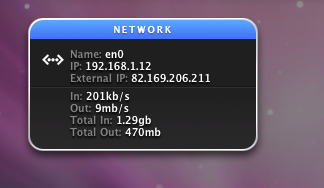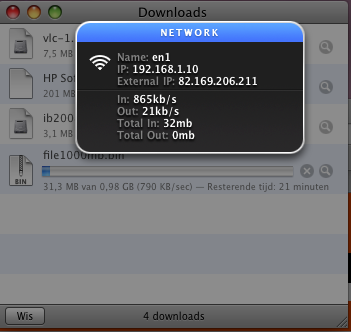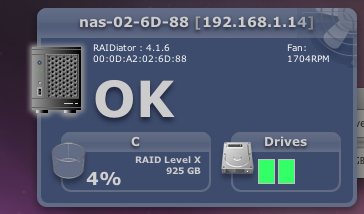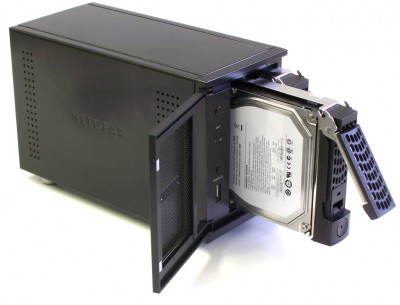 As I own several hundreds of megabytes of digital photographs, documents, spreadsheets and letters, the urge to use a good backup solution raised over time. I do not want to wait and see on one day a fatal harddrive crash…
As I own several hundreds of megabytes of digital photographs, documents, spreadsheets and letters, the urge to use a good backup solution raised over time. I do not want to wait and see on one day a fatal harddrive crash…
In search of a solution (besides backup procedures to CD-ROM/DVD (optical media, which last for 3-5 years before degradation kicks in), I used an external USB harddisk drive. Really easy and simple to use. But a crime when you make manual backups. With the Apple Mac Mini and OS/X 10.5 Leopard, Time Machine will take care and backup the necessary files.
The selection of a Network Attached Storage device
In my residence (private) I had a small budget available. Also when considering the amount of data, it had to be a good choice. Thanks to a good friend (Jeroen v. A.) he mentioned the Netgear ReadyNAS series. After some research it was for my personal needs a good solution, and ordered the ReadyNAS DUO. This NAS has a UTP-connection (suitable for 10/100 and Gigabit ethernet), a USB port on the frontside. Besides this, this system can be configured as RAID-0 and RAID-1 setup. RAID is an abbreviation for ‘redundant array of inexepensive disks’, and with 2 harddisk drives in it, it’s capable to prevent data losses to a minimum by using RAID-1 (mirroring of harddisks). This ‘mirroring’ is a realtime process, and it’s result are 2 harddisk drives with exactly the same information. If 1 of the harddisks suddenly ‘drops dead’ (mechanical/electrical failure of the harddisk), the other harddisk is still in service. Result: no data loss, and still in production! Just swap the defect drive as usual, without power-down the system (also known as ‘hot swappable’).
Setup of the Netgear ReadyNAS Duo
With an utility (RAIDar) I localised my NAS in my network, and set it up as described in the manual. You can also configure it to act as a torrent server to download information, or, even enter power up / power down schedules to minimize energy consumption of this NAS.
As harddisks, I opted for 2 harddisk drives from Samsung: both equiped with SATA2 interfaces, and an individual capacity of 1 Terabyte (approx. 955 Gb formatted as RAID-1 configuration (mirroring).When you choose your harddisks, be sure to check and verify with the latest Hardware Compatibility List of the vendor.
After installation in the brackets (using included screw), and slide these into the bay, the system automatically detects the fresh harddisk and starts synchronization after installation of the second harddisk. For this action, the system had to synchronize these and was ready after 4 hours.
During installation on my Apple (OS/X 10.5) I noticed my ReadyNAS had an older version of firmware. So I updated it immediately with release 4.1.6 (released in july 2009). Take care: the update is approx. 60 Mb in size, and after synchronization approx. 500Mb is claimed by the Netgear to store firmware, settings and other information onto it.

The original firmware did not work with my Apple
Tip: are you using OS/X, be sure to update your firmware, as an option Time Machine (under ‘backup settings’) is THEN available !
![]()
De NAS is visible again in mijn netwerk, after the firmware upgrade to version 4.1.6
The configuration on my Apple to use Time Machine and the ReadyNAS is easy, and described on the Netgear website. After this, you can activate Time Machine and make your first backup. Wireless (on a 802.11G network, with 1 Apple connected to it, and a good signal strength) the initial backup would take approx. 30 hours!!! (1 Gb per every 20 minutes…).After a while I opted to connect a 15 meter UTP CAT5 cable, and use this to back up my data. Result: a steadily data-transfer rate around 8-9Mb per second instead of the 500-800 kB per second was noticed !

Network activity using UTP cables: fast!
Tip: Make use of a wired network connection! The immense amount of data (for myself approx. 90 Gb of photo’s etc.) is a better solution. When using 802.11N WLAN, it could be approx 5 times faster in comparison of the 802.11G network. So later on I created a dedicated UTP connection from my study to the router.

Network activity using Wlan (802.11G): a lot slower
Energy consumption of the Netgear ReadyNAS Duo
When implementing a NAS with RAID capability, you increase your security on information (decrease the rate of data loss due to mechanical/electrical failure of the harddisk). But, this NAS has to be activated all the time for long periods. Frequently booting up/spinning down isn’t that healthy when compared to ‘full time in-service’. The Samsung harddisks I choose (HD103UJ) have a typical power/energy consumption of approx 7-8 Watts.
| Device | Operating System | Power Management | max. Power [Watt] |
Continous Power [Watt] |
Usage [kWh] |
Annual Energy Costs [EUR]* |
|---|---|---|---|---|---|---|
| Netgear ReadyNAS Duo (2x 1 Terabyte HDD) |
Raidar Firmware 4.1.6 |
n.a. | 130 Watt | 27 Watt | 97,2 kWh | EUR 26,24 |
As you can see, the peak in energy consumption is during boot-up phase. During spin-up of both Samsung drives, and verifying parameters, a short burst of 130 Watt is measured. After several seconds it’s stabile at/around 27 Watts in continuous mode. Maybe I can finetune things more over time, using power on/power down schedule, etc.

Using an OSX widget to access the NAS
Financial consequences for the NAS solution
This solution saves me a lot of time considering the ease of Time Machine on my Apple. When I needed to backup approx. 90Gb of data onto DVD-media, it would cost me around 20 discs at a time. When using CD-ROM’s, it would be much more! Backup to USB/Firewire harddisk connected to the system is also possible (also with Time Machine), but I guess you would go crazy every hour the system starts pumping data to backup. Now I can still enjoy the silence of my Mac Mini 🙂
In total this solution costs around EUR 400, and as a result my data is stored on a other location in my house.For the harddisks the costs were about 99 EUR per harddisk.You can also decide to use the ReadyNAS as a RAID-0 configuration, to use both harddisks for the total capacity.
Niels Thijssen, Weblog: Renewable Energy: NOW




Most popular posts